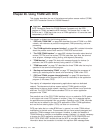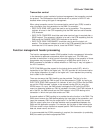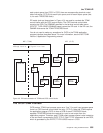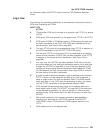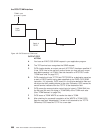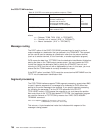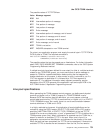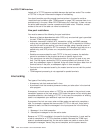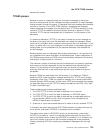For information about the DFHTCT macros, see the
CICS Resource Definition
Guide
.
Logic flow
The following is a generalized description of the sequence of events that occurs in
CICS when interfacing with TCAM.
INPUT STEP
ACTION
A TCAM notifies CICS that it has data for a particular input TCTLE, by posting
its ECB.
B CICS gets a TIOA and attaches it to the special input TCTTE in the TCTLE.
C CICS issues a READ to TCAM that results in TCAM passing the data over
the region boundaries to the CICS TIOA. CICS then indicates that it has
data to process. (See Figure 102 on page 698.)
D The input TCTLE points to the corresponding output TCTLE in response to
the OUTQ specification of the DFHTCT TYPE=LINE macro.
E The individual TCTTEs on the output TCTLE are searched for a matching
source terminal netname. If POOL=YES has been specified, a free TCTTE
is assigned to this source terminal identification. (See Figure 103 on
page 699.)
F If an input user exit (XTCTIN) has been specified, CICS links to the user
exit routine where you may edit input data before passing it to a task (refer
to page “Exit XTCTIN” on page 206). If no exit has been specified, CICS
removes the 8-byte source terminal identification field inserted by TCAM.
For SNA devices, the input communication control byte (CCB) is removed.
No other editing of the data is performed.
G A check is made to determine whether a task is attached to the individual
TCTTE. If there is no task attached, see Step H. If a task is attached, a
check is made to see if the task has issued a READ. If a READ request
exists, see Step J. If not, CICS halts the processing of data in the queue
until the TCTTE is available or the attached task issues a READ.
H CICS attaches the appropriate task. A user exit is available before the
actual attach (refer to page “Exit XTCATT” on page 206). If the task could
not be attached (for example, if a ‘short on storage’ or ‘maximum tasks’
condition exists), CICS records that it has data to process, and exits from
DFHTCP.
I After a task is attached, and if segment processing was specified by
including the C parameter on the OPTCD operand of the DFHTCT
TYPE=SDSCI macro, CICS stores the TCAM segment identifier in the
TCTTE.
J CICS passes control to the attached task.
the CICS-TCAM interface
Chapter 26. Using TCAM with CICS 697





